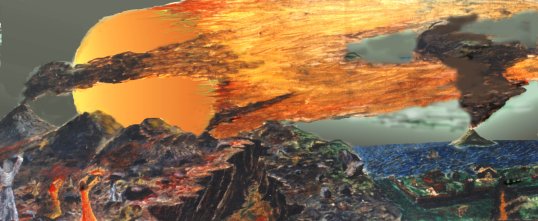Climate Change Ruins Food
Rising CO2 is reducing nutritional
value of food, impacting ecosystems
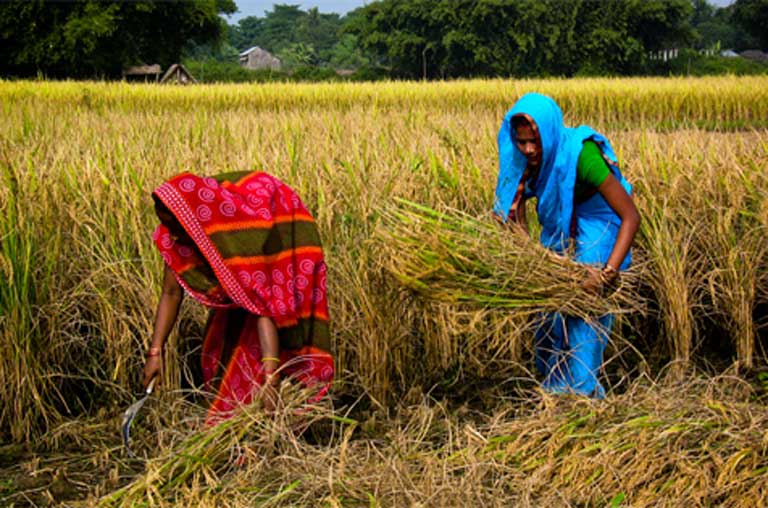
Women harvest rice in
Nepal. An estimated two billion people are already deficient in dietary zinc
and iron, an aspect of malnutrition that has been termed “hidden hunger”. Some
researchers think that shifts in nutritional content in major crops as a
consequence of increasing atmospheric carbon dioxide could lead to more people
being at risk of mineral deficiencies.
Photo courtesy of the International Rice
Research Institute on Flickr under a CC BY-NC-SA 2.0 license.
Heightened atmospheric CO2
levels are cutting the proportions of protein and other vital nutrients in
plants, impacting crops, people, pollinators and ecosystems.
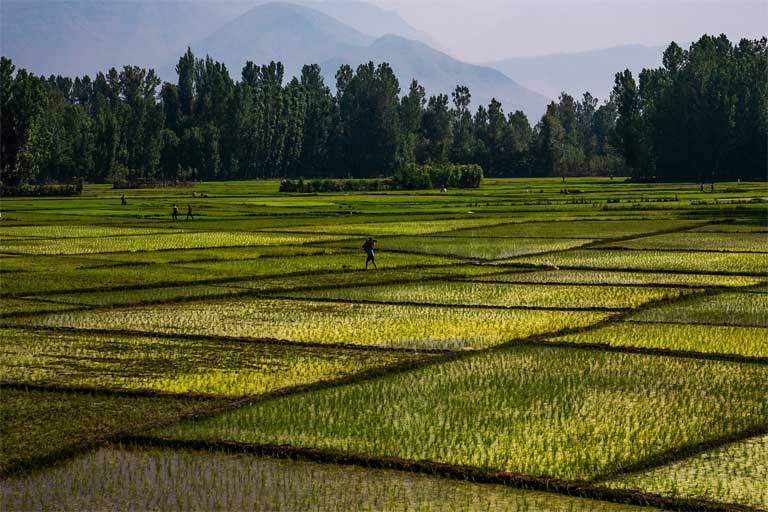
Rice
fields in Kashmir, India. Staple crops such as rice and wheat are forecast to
become less nutritious as a result of increasing carbon dioxide levels in the
atmosphere.
Photo courtesy of sandeepachetan.com travel photography on Flickr under
CC BY-NC-ND 2.0 license
- As CO2 levels rise, so do carbohydrates in plants, increasing food’s sugar content. While carbon-enriched plants grow bigger, scientists are finding that they contain proportionately less protein and nutrients such as zinc, magnesium and calcium.
- A meta-analysis of 7,761 observations of 130 plant species found that overall mineral concentrations in plants declined by about 8 percent in response to elevated CO2 levels — 25 minerals decreased, including iron, zinc, potassium and magnesium.
- New research found that as atmospheric CO2 rose from preindustrial to near current levels, the protein content in goldenrod pollen fell by 30 percent. Bees and other pollinators rely heavily on goldenrod as protein-rich food for overwintering. The loss of pollinators could devastate many of the world’s food crops.
- Research into the correlation between CO2 concentrations and the nutrient content of food is in its early stages. More study is urgently needed to determine how crops and ecosystems will be altered as fossil fuels are burned, plus mitigation strategies.
Among the myriad impacts climate change is having on the world, one in particular may come as a surprise: heightened atmospheric CO2 levels might be adversely affecting the nutritional quality of the food you eat. As carbon dioxide in the atmosphere continues to increase, you could end up eating more sugar and less of important minerals such as zinc, magnesium and calcium — without even realizing it. Those effects could also be reverberating up the food chain and altering ecosystems in as yet poorly understood ways.
For plants, a rise in atmospheric carbon dioxide actually boosts productivity by stimulating photosynthesis. They make more carbohydrate and grow larger — seemingly a good thing. But because other nutrients don’t increase and can’t keep pace with the augmented carbohydrate, this potential boon to our food supply isn’t all that it seems: plants end up having a higher carbohydrate to protein ratio, and relatively lower concentrations of minerals.
Put simply: atmospheric carbon dioxide acts as a sort of fertilizer to grow bigger, leafier plants, but those larger broccolis and lettuces actually contain less nutritional value per portion than their predecessors grown in the preindustrial, pre-fossil fuel world.
And that could be a problem for the world’s already malnourished people, for bees seeking protein-rich pollen so they can safely overwinter, and for ecosystems that could be thrown out of balance by changes in plant nutrition.
The human implications of these ongoing changes to our food supply came under the spotlight in April when the US Global Change Research Program (USGCRP) published a major report on the impact of climate change on human health. One of its key findings was that rising carbon dioxide will reduce the nutritional quality of food.
Allison Crimmins, of the US Environmental Protection Agency, and a lead author of the food safety chapter in the USGCRP report, told Mongabay about some of the ways in which this is likely to be felt around the world: “In certain developing countries, reduced nutritional value of foods will aggravate existing protein deficiencies, particularly in children. In the US and other developed countries however, dietary protein deficiencies are uncommon. In those cases, an increased ratio of carbohydrates and fewer essential minerals — essentially more starchy and more sugary foods — could potentially contribute to or exacerbate existing chronic dietary deficiencies or obesity risks, though how big a role this impact would play on a person’s overall nutrition remains uncertain.”
Deciphering
the CO2 / plant nutrition relationship
In a 2014 study that informed the USGCRP report, researcher Irakli Loladze, of the Bryan College of Health Sciences, described the projected increase in dietary starch and carbohydrate as comparable to adding a “spoonful of sugars” to each 100 grams (3.5 ounces) of dry plant matter. When we’re being told not to eat more than a few teaspoons-worth of sugar per day, this sounds like a lot.
What will be the consequences, Loladze asks, if this additional sugar intake is unavoidable and lifelong? How, for example, might that extra daily suger exacerbate the health problems of the 25 million Americans, 98.4 million Chinese, and 65 million Indians who are part of the growing global diabetes epidemic? And how might those health impacts escalate as atmospheric carbon levels rise annually through the 21st century?
Loladze’s meta-study — which examined thousands of observations of plants grown under high carbon dioxide conditions — was an attempt to prove a theoretical prediction he made back in 2002. We’ve known for decades that plants grown under high carbon dioxide conditions have reduced protein concentrations, and the mechanism behind that change is fairly well understood: more carbohydrate dilutes the protein within the leaf. In addition, increased CO2 changes the rate of transpiration — the uptake of water through the roots and evaporation through the leaves — and affects the amount of nutrients plants draw from the soil. However, higher rates of photosynthesis have different effects on different minerals.
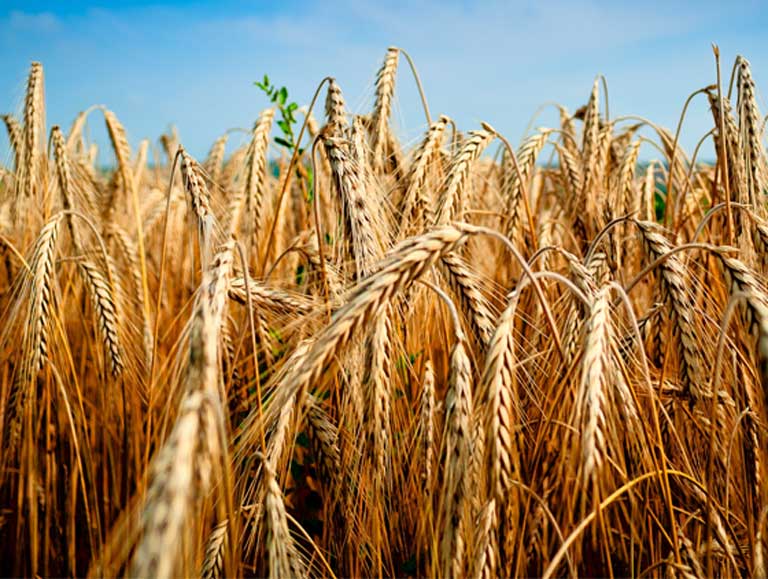
Wheat. Carbon dioxide
promotes plant growth by boosting photosynthesis and carbohydrate production in
the plant. But other nutrients don’t keep pace with this increase, resulting in
higher carbohydrate to protein ratios, and lower concentrations of minerals.
These shifts in nutritional quality could have implications for human health
around the world. Photo courtesy of Žarko Šušnjar on Flickr, under a CC BY-SA
2.0 license
A theory known as ecological stoichiometry — which examines the balance of chemical elements in living systems — led Loladze to reason that minerals should also be affected by a proportional increase in carbohydrate synthesis and the associated knock-on effects this has on plant metabolism. But although a few studies supported his hypothesis in the early 2000s, the evidence was limited.
“There was considerable opposition to my idea,” Loladze told Mongabay. “The stoichiometric theory [upon which I based my argument] was not well known back then. Being a mathematician, I was viewed by some plant experts as an outsider with simplistic arguments that would not pan out in the real world.”
No one would fund the large-scale research effort Loladze needed to investigate his prediction further. Lacking backing and unemployed, he remained determined to test his theory with data. “With no money and no academic affiliation, the only way to get data was to compile [findings] from the existing literature,” he said.
Meanwhile, scientists around the world were increasingly studying the CO2 nutrient effects that interested Loladze, but their results were perplexing: while increases in atmospheric carbon decreased plant mineral concentrations in some studies, minerals increased in others, or showed no significant change
Loladze combined the data from numerous studies — that together had highly variable results — into one large meta-analysis, and he found a clear signal in the noise. A decade after he began work, he proved his prediction to be correct: when he collated the results of 7,761 observations of 130 plant species, he found that overall mineral concentrations in plant tissues declined by around 8 percent in response to elevated carbon dioxide levels. In all, 25 minerals were found to decrease, including iron, zinc, potassium and magnesium.
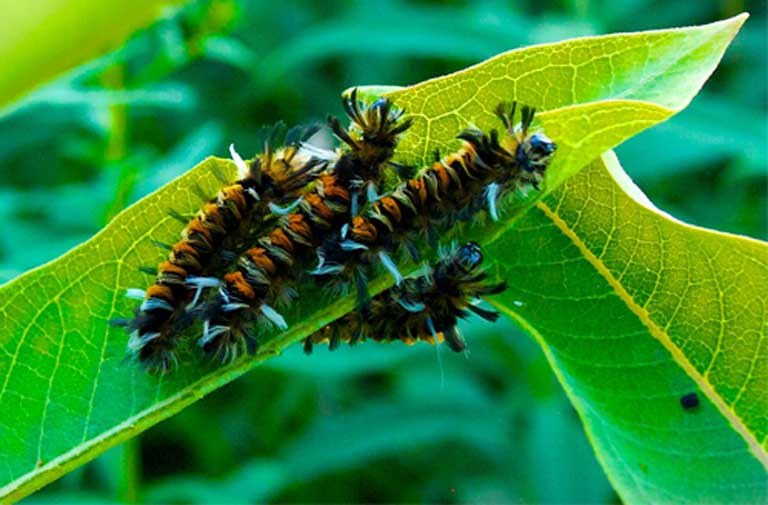
Tussock moth
caterpillars feeding on leaves. Plants and the insects that feed on them form
the basis of most terrestrial ecosystems, so nutritional shifts caused by
rising atmospheric carbon dioxide levels will likely have impacts that extend
up the food chain, but as ecosystems are so complex, it’s difficult to predict
exactly how those changes will play out over time. Photo courtesy of Bjorn
Watland on Flickr under a CC BY-SA 2.0 license
“One important aspect of Loladze’s study is its emphasis on trace elements, like zinc,” James Elser, of Arizona State University, and a proponent of the ecological stoichiometry theory on which Loladze based his work, told Mongabay. “These are often neglected in considerations of plant nutrition but agronomists and others are increasingly aware of the importance of these trace elements [not only] in limiting crop production, but also in human health and are now provisioning them in fertilizers.”
At the same time Loladze was looking at all available data on the nutrient responses of plants, Samuel Myers of Harvard University was also trying to pinpoint the impact of carbon dioxide on plant mineral content.
Whereas Loladze included data on wild as well as food crop species, and non-edible tissues as well as edible, Myers focused specifically on zinc and iron in six food crops. His research team grew the crops under different atmospheric CO2 conditions, and found a similar pattern: both zinc and iron declined by about 5-10 percent in wheat, rice, soybeans, and field peas when grown in a high carbon dioxide setting.
On
the trail of trace elements and “hidden hunger”
Although a more consistent picture is now emerging of what happens to plant nutrients as carbon dioxide levels rise, it’s still not clear exactly how serious a problem this will be for people’s health.
Minor changes in mineral concentrations are unlikely to affect people already consuming more than sufficient quantities for good health, like many in the industrialized world. And if edible plants grow larger under higher carbon dioxide, then simply eating more may compensate for the reduced mineral concentration, though this could have consequences in terms of extra calories consumed.
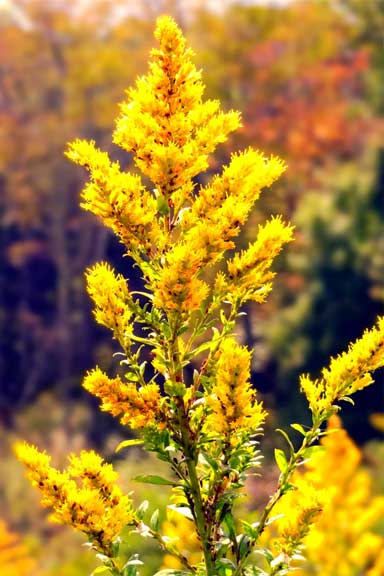 Goldenrod
in Virginia, USA. This is an essential late season source of food for bees, but
a recent study found that with rising carbon dioxide levels, the nutritional
quality of its pollen is decreasing. This could affect bee survival over the
winter. Pollinators such as bees play a crucial part in our food supply. Photo
courtesy of Bridget Leyendecker on Flickr under a CC BY 2.0 license.
Goldenrod
in Virginia, USA. This is an essential late season source of food for bees, but
a recent study found that with rising carbon dioxide levels, the nutritional
quality of its pollen is decreasing. This could affect bee survival over the
winter. Pollinators such as bees play a crucial part in our food supply. Photo
courtesy of Bridget Leyendecker on Flickr under a CC BY 2.0 license.Given the current prevalence of “hidden hunger” some experts expect that rising CO2 levels and corresponding declines in plant nutrition could have a major impact on the health of those already suffering from, or at risk of, malnutrition — with developing nations in Africa and Asia likely to be the hardest hit.
But more research is needed to quantify potential impacts. Studies such as those done by Loladze and Myers have so far only looked at the plants themselves, and not the food products that arise from them, cautions Elser. This “doesn’t necessarily represent the nutritional contents of the foods at the point of consumption, once they have been processed and prepared. So, the ultimate nutritional impact of the CO2 effect requires more investigation.”
“I agree that the conclusions in both [studies] are somewhat alarming, but they should be taken for what they are — just a couple of papers making estimations of potential impact that need to be verified by agroecology, climate, types of foods, etc,” Patrick Webb, Professor of Nutrition at Tufts University, told Mongabay. “And remember that over the [20th century] time-frames the [studies] refer to, there is a rapid expansion of bio-fortified cropping (non-GMO) and a surge in processed food consumption globally, much of which is micrononutrient fortified. I only say this to point out that these papers don’t lead to a conclusion that ‘we’re going to run out of nutrients!’ Simply, that we need to be wary of these kinds of potentially negative impacts of GHGs [greenhouse gases] even on our food supply, and such impacts are bound to be greater in some places than others.”
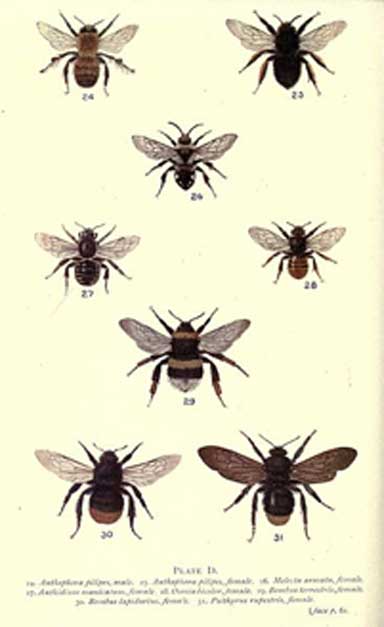 Native
bees, wasps, butterflies, moths, flies and other wild pollinators are vital to
the world’s agriculture and to ecosystems. No one knows for certain how rising
carbon dioxide levels and corresponding falling protein and mineral levels in
plants will impact these species long term. Image by Edward Sanders courtesy of
the Biodiversity Heritage Library
Native
bees, wasps, butterflies, moths, flies and other wild pollinators are vital to
the world’s agriculture and to ecosystems. No one knows for certain how rising
carbon dioxide levels and corresponding falling protein and mineral levels in
plants will impact these species long term. Image by Edward Sanders courtesy of
the Biodiversity Heritage Library“[T]he issues are being discussed among international agriculture researchers, certainly,” continued Webb, who is also Director for USAID’s Feed the Future Nutrition Innovation Lab. “The challenge… is to document the pace of change [in plant nutritional value] for different regions of the world, for different kinds of crops. Only then will we know what kinds of policy changes need to be [put] in place to respond to what is happening (or not happening) at a scale significant enough to warrant action.”
Last year Myers and his colleagues looked at what projected declines in crop zinc content could mean for people in 188 countries. They found that under predicted increases in atmospheric carbon dioxide, 138 million more people would be at risk of zinc deficiency by 2050, largely concentrated in Africa and South Asia.
“The effect we have identified highlights an issue of social justice,” Myers and his co-authors wrote. “The wealthy world’s CO2 emissions are putting the poor in harm’s way.”
While the problem can theoretically be solved by identifying the regions and populations most at risk from hidden hunger, and then focusing mitigations such as mineral fortification programs there, logistical hurdles will likely prevent fortified foods from reaching everyone who need them, now and into the future, Loladze points out in his 2014 paper. Another option is to explore crop cultivars for selective breeding that may be less susceptible to nutrient declines under higher carbon dioxide levels.
Loladze also urges more research, asserting that a greater understanding of exactly how nutrient declines occur could be an important step in responding to their effects. “Elucidating the relative role of each mechanism — dilution [of nutrients] by carbohydrates, reduced transpiration, altered demands for nutrients and so on — and linking them to genomic changes will help us to develop mitigation strategies.”
Food
chain and ecosystem changes
While the full impact on human health of hidden hunger is still being investigated, we’re not the only ones likely to be affected: as plants form the basis of most terrestrial ecosystems “changes in plant based nutrition will extend up to all feeding organisms as part of the food chain,” Lewis Ziska of the US Department of Agriculture told Mongabay.
“Generally this means that the vegetation [in a CO2 enriched environment] is of poorer quality for the animals consuming it — insect herbivores, deer, etc,” Elser explained. “However, this is not necessarily always the case. For example, lower nitrogen content in grass [a consequence of the carbohydrate dilution effect] has been shown to favor the success of locusts.”
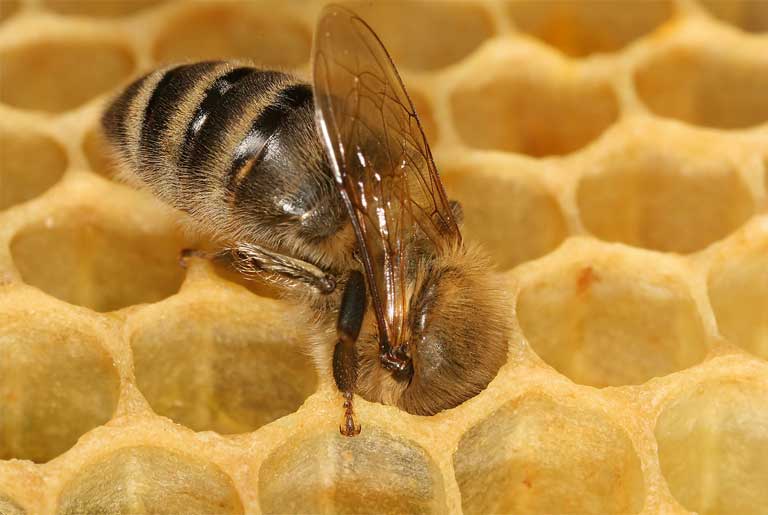
A
worker bee in a honeycomb. The serious decline of protein in goldenrod, an
important fall crop that sustains North American bees through the winter, could
be harming these pollinators, but more study is needed to separate out this
particular dietary stressor from other major stressors including chemical
pesticide use. How CO2 levels are impacting other pollen-providing plants and
pollinators around the world has not been studied. Photo by Richard Bartz,
Munich Makro Freak & Beemaster Hubert Seibring licensed under the Creative
Commons Attribution-Share Alike 2.5 Generic license
Studies have shown that some insect herbivores can compensate for the less nutrient rich plants found in high CO2 environments by eating more, but their growth, development, and reproduction can be affected, Loladze said. Crop damage may also be higher if insects need to consume greater plant quantities to survive. Some laboratory studies have shown that even with compensatory feeding to make up for deficiencies, insects are more likely to starve to death, or could end up consuming damaging quantities of toxic compounds. In the wild, generalist species may respond by switching plant hosts, and over time evolutionary responses could be expected too.
Another ecosystem outcome is the lower nutrient content found in dead leaves, Elser added. “This can slow down the cycling of nutrients in soil and thus impact subsequent productivity of the grassland or forest.”
Research just published by Ziska and his colleagues illustrates another important way CO2 induced nutritional changes are likely impacting wild ecosystems and human food crops. His team examined Smithsonian National Museum specimens of the flowering plant goldenrod collected between 1824 and 2014, to see how pollen quality changed as atmospheric carbon dioxide levels rose — they saw a high correlation. As carbon dioxide concentrations rose from preindustrial levels of 280 parts per million to near current levels of 398 parts per million, the protein content in the most recent pollen samples fell by 30 percent. The greatest protein drop was seen between 1960 and 2014, when atmospheric CO2 levels rose most dramatically.
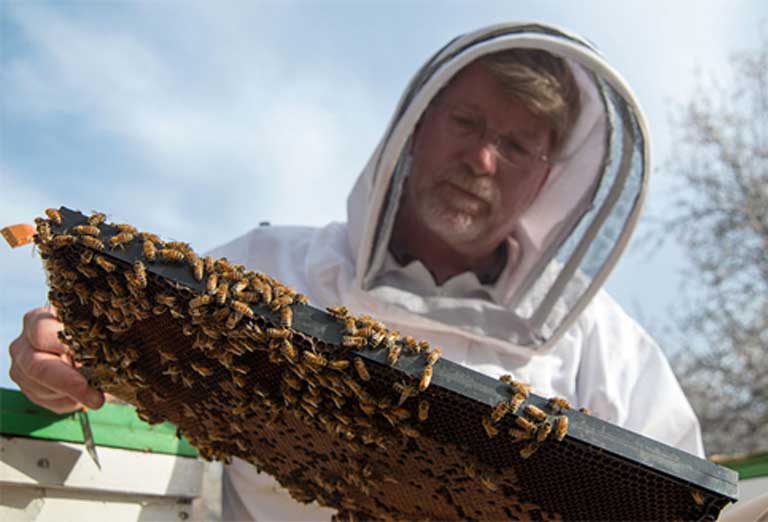
US Department of
Agriculture Agricultural Research Service entomologist Dr. Jeff Pettis examines
a bee colony in McFarland, CA in 2014. Bees are one of nature’s many
pollinators and are crucial to the production for fruits and vegetables
—including apples, squash and almonds. Honeybees are responsible for
pollinating approximately $15 billion worth of US crops annually. Their
disappearance would have massive repercussions for our food supply. Photo by
David Kosling / USDA.
The team also ran a two-year experiment that grew goldenrod under an equivalent range of carbon dioxide concentrations, as well as at levels that are predicted for the coming decades. They observed similar protein declines.
Myers described these findings as “really fascinating,” and explained their significance: “This is important because goldenrod is one of the most ubiquitous late-blooming plants that provides fodder for bees before they overwinter.” Ziska and colleagues say that goldenrod is recognized as being “essential to native bee and honey bee health and winter survival”.
Not only is this likely to directly impact bee populations, “It is reasonable in the case of pollinators to suggest that reduced nutrition will increase vulnerability to other stressors; these other stressors could include things like neonics [pesticides] and/or invasives such as Varroa destructor [parasitic mites],” Ziska said. The loss of pollinators worldwide would drastically impact the many insect pollinated foods we enjoy today ranging from apples to oranges, almonds to cashews, cabbages to broccoli, coffee to tomatoes and blueberries.
“We are starting to design some experiments to see what these changes in protein content might mean for bee behavior and their effectiveness as pollinators,” Myers said. Research Myers and colleagues published last year quantified the role that pollinators play in ensuring human health via food nutrition. Their study concluded that without pollinators as many as 1.4 million additional people would die each year due to non-communicable diseases and micronutrient deficiencies.
The
urgent need for research
The complexity of natural systems, and the numerous confounding factors that affect human health and animal health, make it difficult to foresee exactly how CO2 impacts on the food chain will play out for people or ecosystems. Mitigation strategies may be successful to a degree, once we know what we’re up against. Even better would be to rapidly cut fossil fuel emissions, making sure that long-term carbon dioxide increase predictions don’t materialize.
“The impact on the nutrition of our food is a direct effect of rising greenhouse gas emissions, so it is vital that we reduce these emissions,” Crimmins said. “Taking action on climate change now and reducing the world’s greenhouse gas emissions is not just an environmental imperative; it is crucial for protecting public health.”
“Bottom line is that humanity is operating like a monkey in a rocket ship,” Myers concluded. “We used to be passengers with all the other living creatures on the planet but we have climbed up into the cockpit and taken control. Now we are pushing buttons and flipping levers and rapidly changing most of the biophysical conditions on the planet with really very little idea what the consequences will be for our own health and wellbeing or that of the rest of the biosphere. Undoubtedly, there will be many more surprises along the way.”
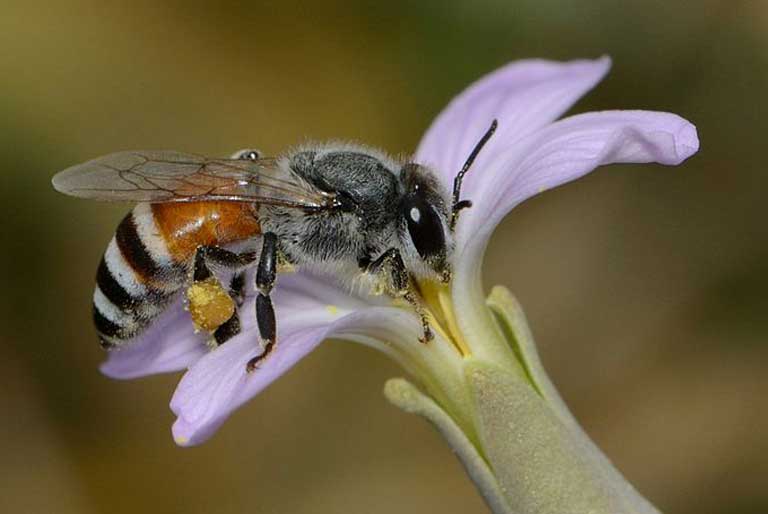
Citations
DeLucia, E.H., Nabity, P.D., Zavala, J.A., and Berenbaum, M.R. (2012) Climate Change: Resetting Plant-Insect Interactions. Plant Physiology 160: 1677-1685
Loladze, I. (2002) Rising atmospheric CO2 and human nutrition: toward globally imbalanced plant stoichiometry? Trends in Ecology and Evolution 17: 457-461
Loladze, I. (2014) Hidden shift of the ionome of plants exposed to elevated CO2 depletes minerals at the base of human nutrition. eLife 3:e02245. DOI: 10.7554/eLife.02245
Müller, C., Elliott, J., and Levermann, A. (2014) Fertilizing hidden hunger. Nature Climate Change 4: 540-541
Myers, S.S., Zanobetti, A., Kloog, I. et.al. (2014). Increasing CO2 threatens human nutrition. Nature 510: 139-142
Myers, S.S., Wessells, K.R., Kloog, I., Zanobetti, A., and Schwartz, J. (2015) Effect of increased concentrations of atmospheric carbon dioxide on the global threat of zinc deficiency: a modelling study. Lancet Global Health 3: e639-e645
Smith, M.R., Singh, G.M., Mozaffarian, D., and Myers, S.S. (2015) Effects of decreases of animal pollinators on human nutrition and global health: a modelling analysis. The Lancet 386: 1964-1972
Ziska, L., Crimmins, A., Auclair, A., DeGrasse, S., Garofalo, J.F., Khan, A.S., Loladze, I., Pérez de León, A.A., A. Showler, J. Thurston, and I. Walls, (2016) Ch. 7: Food Safety, Nutrition, and Distribution. The Impacts of Climate Change on Human Health in the United States: A Scientific Assessment. U.S. Global Change Research Program, Washington, DC, 189–216. http://dx.doi.org/10.7930/J0ZP4417
Ziska, L.H., Pettis, J.S., Edwards, J., Hancock, J.E., Tomecek, M.B., Clark, A., Dukes, J.S., Loladze, I. and Polley, H.W. (2016) Rising atmospheric CO2 is reducing the protein concentration of a floral pollen source essential for North American bees. Proc. R. Soc. B. 283: 20160414
Article published by Glenn
Scherer
From Mongabay @ https://news.mongabay.com/2016/06/rising-co2-is-reducing-nutritional-value-of-food-impacting-ecosystems/
For more information about climate change see http://nexusilluminati.blogspot.com/search/label/climate%20change
- Scroll down
through ‘Older Posts’ at the end of each section
Do you LIKE this uniquely informative site?
Hours of effort by a genuinely incapacitated invalid are
required every day to maintain, write, edit, research, illustrate, moderate and
publish this website from a tiny cabin in a remote forest.
Now that most people use ad blockers and view these posts
on phones and other mobile devices, sites like this earn an ever shrinking
pittance from advertising sponsorship. This site needs your help.
Like what you see? Please give anything you can -
Contribute any amount and receive at least one
New Illuminati eBook!
(You can use a card securely if you don’t use Paypal)
Please click below -
Spare Bitcoin
change?
And it costs nothing
to share this post on Social Media!
Dare to care and
share - YOU are our only advertisement!
For further enlightening
information enter a word or phrase into the random synchronistic search box @
the top left of http://nexusilluminati.blogspot.com
And see
New Illuminati – http://nexusilluminati.blogspot.com
New Illuminati on Facebook - https://www.facebook.com/the.new.illuminati
New Illuminati Youtube Channel - https://www.youtube.com/user/newilluminati/playlists
New Illuminati’s OWN Youtube Videos
-
New Illuminati on Google+ @ For
New Illuminati posts - https://plus.google.com/u/0/+RamAyana0/posts
New Illuminati on Twitter @ www.twitter.com/new_illuminati
New Illuminations –Art(icles) by
R. Ayana @ http://newilluminations.blogspot.com
The Her(m)etic Hermit - http://hermetic.blog.com
DISGRUNTLED SITE ADMINS PLEASE NOTE –
We provide
a live link to your original material on your site (and links via social
networking services) - which raises your ranking on search engines and helps
spread your info further!
This site
is published under Creative Commons (Attribution) CopyRIGHT (unless an
individual article or other item is declared otherwise by the copyright
holder). Reproduction for non-profit use is permitted & encouraged - if you
give attribution to the work & author and include all links in the original
(along with this or a similar notice).
Feel free
to make non-commercial hard (printed) or software copies or mirror sites - you
never know how long something will stay glued to the web – but remember
attribution!
If you
like what you see, please send a donation (no amount is too small or too large)
or leave a comment – and thanks for reading this far…
Live long
and prosper! Together we can create the best of all possible worlds…
From the New Illuminati – http://nexusilluminati.blogspot.com
